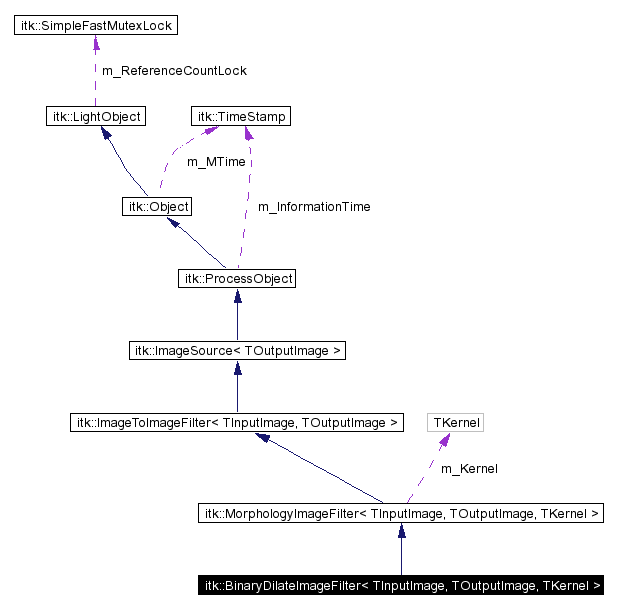
#include <itkBinaryDilateImageFilter.h>
Inheritance diagram for itk::BinaryDilateImageFilter:


Public Types | |
| typedef BinaryDilateImageFilter | Self |
| typedef MorphologyImageFilter< TInputImage, TOutputImage, TKernel > | Superclass |
| typedef SmartPointer< Self > | Pointer |
| typedef SmartPointer< const Self > | ConstPointer |
| typedef Superclass::PixelType | PixelType |
| typedef ConstNeighborhoodIterator< TInputImage > | NeighborhoodIteratorType |
| typedef ConstSmartNeighborhoodIterator< TInputImage > | SmartNeighborhoodIteratorType |
| typedef TKernel | KernelType |
| typedef KernelType::ConstIterator | KernelIteratorType |
Public Methods | |
| virtual const char * | GetClassName () const |
| virtual void | SetDilateValue (PixelType _arg) |
| virtual PixelType | GetDilateValue () |
Static Public Methods | |
| Pointer | New () |
Protected Methods | |
| BinaryDilateImageFilter () | |
| ~BinaryDilateImageFilter () | |
| void | PrintSelf (std::ostream &os, Indent indent) const |
| PixelType | Evaluate (const NeighborhoodIteratorType &nit, const KernelType &kernel) |
| PixelType | Evaluate (const SmartNeighborhoodIteratorType &nit, const KernelType &kernel) |
Dilate an image using binary morphology. Gray scale images can be processed as binary images by selecting a "DilateValue". Pixel values matching the dilate value are considered the "foreground" and all other pixels are "background". This is useful in processing segmented images where all pixels in segment #1 have value 1 and pixels in segment #2 have value 2, etc. A particular "segment number" can be processed. DilateValue defaults to the maximum possible value of the PixelType.
Binary dilation will set a pixel as the "DilateValue" if any of the pixels in the image under the structuring element have a value of "DilateValue" and that structuring element value is greater than 0.
The structuring element is assumed to be composed of binary values (zero or one). Only elements of the structuring element having values > 0 are candidates for affecting the center pixel.
If none of the pixels under the structuring element have DilateValue, the pixel under the center pixel value of the structuring element is unchanged. If the center pixel is "in" the structuring element (value > 0), then leaving the pixel unchanged is the right things to do since that is most appropriate "background" value for the pixel. If the center pixel is not part of the structuring element (a rare designation), then leaving the pixel unchanged is not correct in the strict morphological definition (operating on an image with multiple background values is not defined in morphology). Under these conditions, the center pixel should be set to "a" background value. However, we do not know which background value to set it to.
For the each input image pixel,
Definition at line 67 of file itkBinaryDilateImageFilter.h.
|
|||||
|
Reimplemented from itk::MorphologyImageFilter< TInputImage, TOutputImage, TKernel >. Definition at line 76 of file itkBinaryDilateImageFilter.h. |
|
|||||
|
Kernel (structuring element) iterator Reimplemented from itk::MorphologyImageFilter< TInputImage, TOutputImage, TKernel >. Definition at line 97 of file itkBinaryDilateImageFilter.h. |
|
|||||
|
Kernel typedef Reimplemented from itk::MorphologyImageFilter< TInputImage, TOutputImage, TKernel >. Definition at line 94 of file itkBinaryDilateImageFilter.h. |
|
|||||
|
Neighborhood iterator type Reimplemented from itk::MorphologyImageFilter< TInputImage, TOutputImage, TKernel >. Definition at line 89 of file itkBinaryDilateImageFilter.h. |
|
|||||
|
Declaration of Pixel Type Reimplemented from itk::MorphologyImageFilter< TInputImage, TOutputImage, TKernel >. Definition at line 85 of file itkBinaryDilateImageFilter.h. |
|
|||||
|
Reimplemented from itk::MorphologyImageFilter< TInputImage, TOutputImage, TKernel >. Definition at line 75 of file itkBinaryDilateImageFilter.h. |
|
|||||
|
Standard class typedefs. Reimplemented from itk::MorphologyImageFilter< TInputImage, TOutputImage, TKernel >. Definition at line 72 of file itkBinaryDilateImageFilter.h. |
|
|||||
|
Reimplemented from itk::MorphologyImageFilter< TInputImage, TOutputImage, TKernel >. Definition at line 91 of file itkBinaryDilateImageFilter.h. |
|
|||||
|
Reimplemented from itk::MorphologyImageFilter< TInputImage, TOutputImage, TKernel >. Definition at line 74 of file itkBinaryDilateImageFilter.h. |
|
|||||||||
|
|
|
|||||||||
|
Definition at line 109 of file itkBinaryDilateImageFilter.h. |
|
||||||||||||||||
|
Evaluate image neighborhood with kernel to find the new value for the center pixel value It will return the DilateValue if any of the image pixels in the neighborhood have the DilateValue and that pixel's corresponding element in the structuring element is positive. This version of Evaluate is used for boundary pixels. Implements itk::MorphologyImageFilter< TInputImage, TOutputImage, TKernel >. |
|
||||||||||||||||
|
Evaluate image neighborhood with kernel to find the new value for the center pixel value It will return the DilateValue if any of the image pixels in the neighborhood have the DilateValue and that pixel's corresponding element in the structuring element is positive. This version of Evaluate is used for non-boundary pixels. Implements itk::MorphologyImageFilter< TInputImage, TOutputImage, TKernel >. |
|
|||||||||
|
Runtime information support Reimplemented from itk::MorphologyImageFilter< TInputImage, TOutputImage, TKernel >. |
|
|||||||||
|
Get the value in the image considered as "foreground". Defaults to maximum value of PixelType. |
|
|||||||||
|
Standard New method Reimplemented from itk::ImageToImageFilter< TInputImage, TOutputImage >. |
|
||||||||||||||||
|
Methods invoked by Print() to print information about the object including superclasses. Typically not called by the user (use Print() instead) but used in the hierarchical print process to combine the output of several classes. Reimplemented from itk::MorphologyImageFilter< TInputImage, TOutputImage, TKernel >. |
|
||||||||||
|
Set the value in the image to consider as "foreground". Defaults to maximum value of PixelType. |
 1.2.15 written by Dimitri van Heesch,
© 1997-2000
1.2.15 written by Dimitri van Heesch,
© 1997-2000